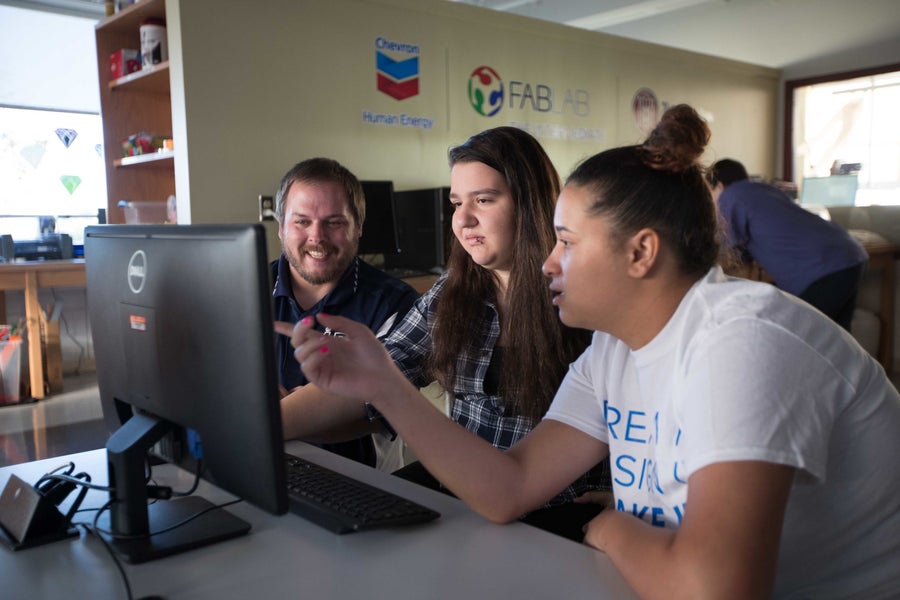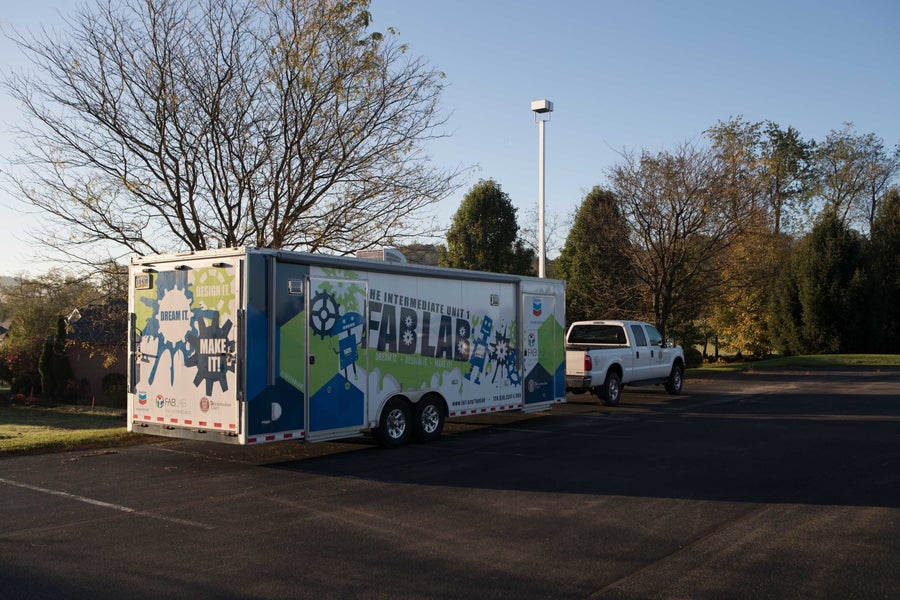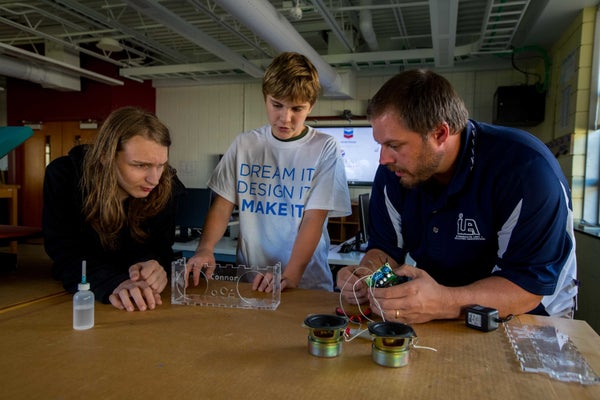This article was published in Scientific American’s former blog network and reflects the views of the author, not necessarily those of Scientific American
Imagine a school with a state-of-the-art fabrication lab. The students have designed and built a custom speaker for Adam Savage (of Mythbusters fame) and created the awards presented at a business association banquet held at Heinz Field. The curriculum is heavily biased towards project-based learning and even features occasional Shark Tank style presentations of student products in front of local business leaders. It sounds like the story of a highly selective and STEM-based magnet school. Maybe a private academy? While the students at this school have been pooled from across school districts, they were not the ones who had been thriving in their home classrooms. Instead the student population is largely made up of alternative education students, therapeutic emotional support students, students with disabilities, and students who have not behaviorally conformed in their own schools.
Bringing any kind of change to K-12 education is typically a slow and labored process. The bigger the population (class, school, district, etc.), the slower the change. And the motivations behind those changes usually have to fit in neat, little boxes. Changes meant to improve student behavior don’t typically overlap with those to increase career readiness. But every so often a clear vision from area leadership and buy-in from the front lines of teaching can come together to try something dramatic.
Pennsylvania’s Intermediate Units (IUs) are regional education agencies with reach beyond the level of school districts but below the Board of Education. While their responsibilities span from adult education to teacher training, one key population they support is the students that are not being served by traditional instructional approaches and settings. Some of this support is integrated across public schools, but some occurs in campus schools where additional resources – like counseling and specialized educators – are available. Students attending campus schools often do so on a temporary basis, with the overall goal of successfully re-matriculating back into home schools.
On supporting science journalism
If you're enjoying this article, consider supporting our award-winning journalism by subscribing. By purchasing a subscription you are helping to ensure the future of impactful stories about the discoveries and ideas shaping our world today.
With the complex and overlapping goals of serving specialized student needs, maintaining state academic standards, and managing high rates of behavioral and attendance issues, an Intermediate Unit campus school may not seem like the place where administrators would want to pilot new instruction initiatives. But a few years ago, the Executive Director of Intermediate Unit 1 (IU1) wanted to find ways to do more to serve their campus populations – both short-term and otherwise. Even though many the students at the IU1 campus schools had already demonstrated a mismatch with traditional instruction, approaches at the campus schools were also heavily book-based and depended on some of those same techniques. Don Martin, Assistant Executive Director of IU1, was tasked with working with the community to come up with a new approach. “I was given tremendous latitude,” Martin explained. “We just knew we had to do more than what we were doing. There had to be more options.”

Credit: Chevron
The options they were most excited about included project-based learning and instruction that was more hands-on than book-based. And when looking into the investments required to lay the groundwork for such a learning environment – financial, personnel, and otherwise – IU1 and Chevron crossed paths at an extremely opportune moment. Chevron had started a collaboration with the Fab Foundation – originally based out of MIT’s Center for Bits & Atoms Fab Lab Program – to set up ten fabrication labs around the country. Janet Auer, the Global Social Investment Advisor at Chevron, said that Chevron was excited by the Fab Foundation mission to provide access to the tools and education to allow “anyone to make (almost) anything.” But she was adamant that they did not want to simply supply funds for equipment; they wanted to work with communities to build something that would become an integrated and sustainable resource long after their initial investment. The initial investment included three years of funding, including a full-time staff member, and conversations with potential communities focused on how those three years could be used to build something that would last.
The discussions with IU1 had an added component. Given the reach that IU1 has – across school districts spanning three counties – their proposal to place the lab at one of the IU1 campus schools was a bold one. Colonial campus school (one of the IU1 campus schools) has one of the highest populations of alternative education, special education, mental health, and emotional support students. There was resistance – both from other schools and from local teachers – about placing laser cutters in the hands of students with behavioral concerns.
The initial hope had been that offering new instructional approaches would improve academic engagement for the student body. But the effects have been felt far beyond the lab itself. Attendance issues at Colonial dropped dramatically. Behavioral incidents dropped across the student population – not just in the lab. Initially the mental health students had not been included in the lab scheduling, but on one trip to Colonial Martin came across an 8-year-old student at the start of a meltdown in the hallway. On a whim, Martin took the student to the FabLab and demonstrated how the 3-D printer worked. The situation de-escalated rapidly. Time in the FabLab is now a part of everyday curriculum for all mental health students. Any doubt school leadership may have had about this change snapped into sharp focus when scheduling issues that limited lab access led to a spike in behavioral incidents throughout the school.

Assistant Executive Director of IUA Don Martin considers any day that the mobile lab is parked a missed opportunity. Credit: Chevron
But perhaps the most dramatic change can be seen in student attitudes. Students who had previously had issues with group work were collaborating in the lab. Students that had refused to talk in the classroom were presenting their original products in front of panels. Exit surveys that had previously mentioned fast-food positions as anticipated work after graduation started mentioning ambitions to build skills to pursue technical positions. And with the expansion of the FabLab resources into other schools and districts across IU1’s reach, students returning from Colonial are often returning with skills that make them an asset in the lab. Leaving may have been because of behavioral issues or academic struggles, but returning can be with the chance for leadership and better self-confidence.
IU1 and Chevron have been so excited about the collaboration that they have partnered on a mobile FabLab as well. Martin is passionate about bringing that experience to as many audiences, young and old, as possible. Some of the counties served by IU1 have the highest unemployment and poverty rates in the state, and bringing the next generation of technical skills is a natural fit for a region previously dominated by mining and machinist work. Auer said that one of the goals in supporting FabLabs was to have new populations look at STEM and say, “This is also for me.” At Colonial that has certainly been the case. Martin and Auer hope to see the effect expand around the state and show how corporate partnerships can focus on community buy-in and sustainability. And Martin is excited to be pursuing instructional opportunities that help build confidence and change attitudes for underestimated student populations rather than just checking off academic boxes and sending them on their way.
The IU1 Fab Lab is a partnership between Chevron, the Fab Foundation, and Intermediate Unit 1.
